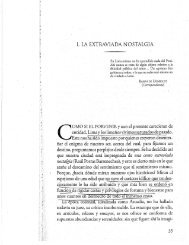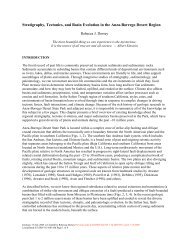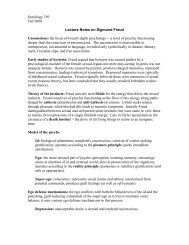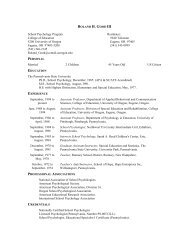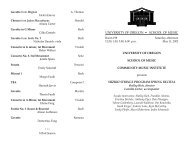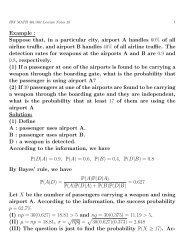Prehistoric era Lenape in New York - University of Oregon
Prehistoric era Lenape in New York - University of Oregon
Prehistoric era Lenape in New York - University of Oregon
Create successful ePaper yourself
Turn your PDF publications into a flip-book with our unique Google optimized e-Paper software.
<strong>Prehistoric</strong> <strong>era</strong><br />
About 75,000 years ago, dur<strong>in</strong>g the last ice age, the area <strong>of</strong> present day <strong>New</strong><br />
<strong>York</strong> City was at the edge <strong>of</strong> the ice sheet that stretched down from Canada. The<br />
ice sheet covered the site <strong>of</strong> the present city to a depth <strong>of</strong> approximately 1000<br />
feet (300 m). The glaciers scraped <strong>of</strong>f much <strong>of</strong> the top layers <strong>of</strong> material <strong>in</strong> the<br />
region, expos<strong>in</strong>g underly<strong>in</strong>g much-older bedrock, <strong>in</strong>clud<strong>in</strong>g gneiss and marble<br />
that dates from 500 million years ago.<br />
Approximately 15,000 years ago, when the ice sheet began retreat<strong>in</strong>g, the glacier<br />
left beh<strong>in</strong>d a term<strong>in</strong>al mora<strong>in</strong>e that now forms the hills <strong>of</strong> Long Island and Staten<br />
Island. The two islands were not yet separated by the Narrows, which were<br />
formed approximately 6,000 years ago when the waters <strong>of</strong> the Upper Bay broke<br />
through <strong>in</strong> the Lower Bay.<br />
Archeological excavations <strong>in</strong>dicate that the first humans settled the area as early<br />
as 9,000 years ago. These early <strong>in</strong>habitants left beh<strong>in</strong>d hunt<strong>in</strong>g implements and<br />
bone heaps. The area was abandoned, however, possibly because the warm<strong>in</strong>g<br />
climate <strong>of</strong> the region lead to the local ext<strong>in</strong>ction <strong>of</strong> many larger game species<br />
upon which the early <strong>in</strong>habitants depended for food.<br />
A second wave <strong>of</strong> <strong>in</strong>habitants entered the region approximately 3,000 years ago<br />
and left beh<strong>in</strong>d more advanced hunt<strong>in</strong>g implements such as bows and arrows.<br />
The rema<strong>in</strong>s <strong>of</strong> approximately 80 such early encampments have been found<br />
throughout the city. The region has probably rema<strong>in</strong>ed cont<strong>in</strong>ually <strong>in</strong>habited from<br />
that time.<br />
<strong>Lenape</strong> <strong>in</strong> <strong>New</strong> <strong>York</strong><br />
The area was long <strong>in</strong>habited by the <strong>Lenape</strong>; <strong>Lenape</strong> <strong>in</strong> canoes met Giovanni da<br />
Verrazzano, the first European explorer to enter <strong>New</strong> <strong>York</strong> Harbor, <strong>in</strong> 1524.<br />
Giovanni da Verrazzano named this place <strong>New</strong> Angouleme (Nouvelle<br />
Angoulême <strong>in</strong> french) <strong>in</strong> the honor <strong>of</strong> the French k<strong>in</strong>g Francis I ('François 1er' <strong>in</strong><br />
french). (Believed to be after this event) A French explorer and mapper, Samuel<br />
de Champla<strong>in</strong>, described his explorations through <strong>New</strong> <strong>York</strong> <strong>in</strong> 1608. A year later<br />
Henry Hudson, an Englishman work<strong>in</strong>g for the Dutch, claimed the area <strong>in</strong> the<br />
name <strong>of</strong> the Netherlands. It was to be called <strong>New</strong> Netherlands.<br />
The <strong>Lenape</strong> or Lenni-<strong>Lenape</strong> (later named Delaware Indians by Europeans)<br />
were, <strong>in</strong> the 1600s, loosely organized bands <strong>of</strong> Native American people<br />
practic<strong>in</strong>g small-scale agriculture to augment a largely mobile hunter-gatherer<br />
society <strong>in</strong> the region around the Delaware River, the lower Hudson River, and<br />
western Long Island Sound. The <strong>Lenape</strong> were the people liv<strong>in</strong>g <strong>in</strong> the vic<strong>in</strong>ity <strong>of</strong><br />
<strong>New</strong> <strong>York</strong> Bay and <strong>in</strong> the Delaware Valley at the time <strong>of</strong> the arrival <strong>of</strong> the<br />
Europeans <strong>in</strong> the 16th and 17th century. Their Algonquian language is also<br />
known as either <strong>Lenape</strong> or Delaware.
The quick dependence <strong>of</strong> the <strong>Lenape</strong> on European goods, and the need for fur to<br />
trade with the Europeans, eventually resulted <strong>in</strong> a disaster with an overharvest<strong>in</strong>g<br />
<strong>of</strong> the beaver population <strong>in</strong> the lower Hudson. The fur source thus exhausted, the<br />
Dutch shifted their op<strong>era</strong>tions to present-day Upstate <strong>New</strong> <strong>York</strong>. The <strong>Lenape</strong><br />
population fell <strong>in</strong>to disease and decl<strong>in</strong>e. Likewise, the differences <strong>in</strong> conceptions<br />
<strong>of</strong> property rights between the Europeans and the <strong>Lenape</strong> resulted <strong>in</strong> widespread<br />
confusion among the <strong>Lenape</strong> and the loss <strong>of</strong> their lands. After the Dutch arrival <strong>in</strong><br />
the 1620s, the <strong>Lenape</strong> were successfully able to restrict Dutch settlement to<br />
present-day Jersey City along the Hudson until the 1660s, when the Dutch f<strong>in</strong>ally<br />
established a garrison at Fort Bergen, allow<strong>in</strong>g settlement west <strong>of</strong> the Hudson.<br />
<strong>Lenape</strong> <strong>in</strong>habitants<br />
Ma<strong>in</strong> article: <strong>Lenape</strong><br />
At the time <strong>of</strong> the arrival <strong>of</strong> the first Europeans, the area around what would later<br />
be called <strong>New</strong> <strong>York</strong> Bay was populated primarily by the Munsee branch <strong>of</strong> the<br />
<strong>Lenape</strong>, a people <strong>in</strong> the ethnic and l<strong>in</strong>guistic Algonquian family, loosely<br />
connected to them by a common language-root. The <strong>Lenape</strong> called the region<br />
Scheyischbi, or "the place border<strong>in</strong>g the ocean", and perhaps <strong>Lenape</strong>hok<strong>in</strong>g,<br />
mean<strong>in</strong>g "place where the <strong>Lenape</strong> dwell," although there is not universal<br />
agreement among scholars regard<strong>in</strong>g this. The <strong>Lenape</strong> hunted, fished, and<br />
gathered roughly 150 species <strong>of</strong> edible wild plants, as well as us<strong>in</strong>g slash and<br />
burn agriculture, with the women sow<strong>in</strong>g such crops as the "Three Sisters" <strong>of</strong><br />
maize, beans, and squash. The harbor and rivers also provided for rich fish<strong>in</strong>g,<br />
especially <strong>of</strong> oyster and striped bass.<br />
The <strong>Lenape</strong> lived <strong>in</strong> small <strong>in</strong>ter-connected groups mov<strong>in</strong>g seasonally from camp<br />
to camp and, accord<strong>in</strong>g to best historical analysis, had no concept <strong>of</strong> private<br />
ownership <strong>of</strong> land. The <strong>Lenape</strong> had no written language, but many <strong>New</strong> <strong>York</strong><br />
place names are derived phonetically from the orig<strong>in</strong>al <strong>Lenape</strong> words, <strong>in</strong>clud<strong>in</strong>g<br />
Raritan Bay between Staten Island and <strong>New</strong> Jersey, Rockaway <strong>in</strong> Queens, and<br />
Canarsie <strong>in</strong> Brooklyn. Manhattan is an <strong>in</strong>terpretation <strong>of</strong> a word <strong>in</strong> the Munsee<br />
dialect mean<strong>in</strong>g manna-hatta or 'hilly island.' In addition to water travel, the<br />
<strong>Lenape</strong> moved through the region on an extensive system <strong>of</strong> trails, many <strong>of</strong><br />
which would later become major roads and thoroughfares <strong>of</strong> the city.<br />
The <strong>Lenape</strong> engaged a network <strong>of</strong> trade among themselves and with other tribes<br />
<strong>in</strong> northeastern North America through a system <strong>of</strong> barter. The pr<strong>in</strong>cipal medium<br />
<strong>of</strong> barter was wampum, which largely consisted <strong>of</strong> ornamented hand-made belts<br />
<strong>of</strong> crafted purple and white mollusk shells. The particular species required for<br />
wampum was found exclusively <strong>in</strong> the areas around Long Island Sound, <strong>in</strong> areas<br />
controlled by the Pequots. Archaeological evidence <strong>of</strong> wampum manufactured <strong>in</strong><br />
the <strong>New</strong> <strong>York</strong> area has been found throughout the Northeast and Great Lakes<br />
area, <strong>in</strong>dicat<strong>in</strong>g an extensive trad<strong>in</strong>g network that flourished among the <strong>Lenape</strong>
and other Native ethnic groups such as the Iroquois, who at times <strong>in</strong>habited the<br />
area <strong>of</strong> present-day western <strong>New</strong> <strong>York</strong> State. In effect, <strong>New</strong> <strong>York</strong> City was a<br />
f<strong>in</strong>ancial center even before the arrival <strong>of</strong> the Europeans.<br />
Source: Wikipedia<br />
------------------------------------------------------------------------------------------------------------<br />
Navigat<strong>in</strong>g the <strong>Lenape</strong> Trails<br />
In the spr<strong>in</strong>g <strong>of</strong> 1626, accord<strong>in</strong>g to historical accounts, Peter M<strong>in</strong>uit, the director<br />
gen<strong>era</strong>l <strong>of</strong> <strong>New</strong> Netherland, purchased the island <strong>of</strong> Manhattan from the <strong>Lenape</strong><br />
Indians <strong>in</strong> exchange for beads, cloth, and tr<strong>in</strong>kets said to be worth $24. This<br />
legendary purchase resulted <strong>in</strong> <strong>New</strong> Amsterdam, which later became <strong>New</strong> <strong>York</strong><br />
City.<br />
At the time <strong>of</strong> the Dutch arrival, around 15,000 <strong>Lenape</strong> lived <strong>in</strong> the area now<br />
known as <strong>New</strong> <strong>York</strong> City. After the Dutch came to Manhattan, many <strong>Lenape</strong><br />
moved <strong>in</strong>to the area that is now Pennsylvania and Delaware. Many <strong>of</strong> those who<br />
rema<strong>in</strong>ed <strong>in</strong> the <strong>New</strong> <strong>York</strong> City area were killed by smallpox.<br />
There are no modern <strong>Lenape</strong> communities with<strong>in</strong> <strong>New</strong> <strong>York</strong> City, but the <strong>Lenape</strong><br />
have left their legacy <strong>in</strong> the city’s streets. The old <strong>Lenape</strong> pathways on<br />
Manhattan island eventually evolved <strong>in</strong>to modern streets.<br />
<strong>New</strong> <strong>York</strong> City’s “Great White Way,” Broadway, used to be the Mohican Trail.<br />
Greenwich Village was a <strong>Lenape</strong> village on the banks <strong>of</strong> Manetta Creek; sacred<br />
council fires were held at Bowl<strong>in</strong>g Green. Frankl<strong>in</strong> Square and Cherry Street<br />
were the site <strong>of</strong> vast <strong>Lenape</strong> cherry orchards.<br />
On Saturday July 26, the South Street Seaport Museum is host<strong>in</strong>g a tour <strong>of</strong> the<br />
<strong>Lenape</strong> trails on Manhattan’s Lower East Side and the South Street Seaport<br />
district.<br />
Focus<strong>in</strong>g on the trails, former cherry orchards and the ancient canoe cross<strong>in</strong>gs <strong>of</strong><br />
the <strong>Lenape</strong> people <strong>of</strong> the Lower East Side, the tour will be given by Evan T.
Pritchard, author <strong>of</strong> No Word for Time: The Way <strong>of</strong> the Algonqu<strong>in</strong> People, and a<br />
descendant <strong>of</strong> the Micmac people (part <strong>of</strong> the Algonqu<strong>in</strong> Nations).<br />
The <strong>Lenape</strong> Trails <strong>of</strong> the Lower East Side tour departs from the Melville Gallery<br />
at 213 Water Street, <strong>of</strong>f Fulton Street <strong>in</strong> lower Manhattan. The tour, which lasts<br />
from 1 p.m. to 3 p.m., will cost $5 and is free to South Street Sea Port Museum<br />
members. For more <strong>in</strong>formation, visit www.southstseaport.org.<br />
--------------------------------------------------------------------------------------------------------<br />
NYC's First Apartment Dwellers: The <strong>Lenape</strong> Indians<br />
By: Tony the Tour Guy<br />
tonythetourguy@yahoo.com<br />
About the only th<strong>in</strong>g that most <strong>of</strong> us have heard about the Native Americans who<br />
<strong>in</strong>habited the <strong>New</strong> <strong>York</strong> City area was that they sold Manhattan to the Dutch for<br />
$24. Let's talk a bit about the fasc<strong>in</strong>at<strong>in</strong>g people who lived <strong>in</strong> the area prior to<br />
European settlement.<br />
<strong>Lenape</strong> means "men" or "people" <strong>in</strong> Munsee, the dialect spoken by the first <strong>New</strong><br />
<strong>York</strong>ers, who called the area <strong>Lenape</strong>hok<strong>in</strong>g, or "Place where the <strong>Lenape</strong> live."<br />
They were Algonqu<strong>in</strong>s, not Iroquois, as some <strong>of</strong> us were taught <strong>in</strong> grammar<br />
school. The Iroquois were further upstate, and they and the <strong>Lenape</strong> frequently<br />
fought. Estimates are that, at the time <strong>of</strong> the Dutch settlers' arrival, approximately<br />
15,000 Indians lived <strong>in</strong> the area which we know call <strong>New</strong> <strong>York</strong> City, with another<br />
30 to 50,000 resid<strong>in</strong>g <strong>in</strong> the larger area from Eastern Connecticut to Central <strong>New</strong><br />
Jersey. They lived <strong>in</strong> small, loosely-formed groups based upon k<strong>in</strong>ship, and did<br />
not form tribes <strong>in</strong> the way usually portrayed by Hollywood. Each group, headed<br />
by a sachem, typically occupied a series <strong>of</strong> campsites, to which they moved<br />
depend<strong>in</strong>g upon the seasons. Dur<strong>in</strong>g fish<strong>in</strong>g season, for example, a group would<br />
be at its waterside site, where they would stay until autumn, when they would<br />
move further <strong>in</strong>land to harvest their crops.<br />
The <strong>Lenape</strong> diet was rich and varied. They hunted deer, wild turkey and other<br />
game, and also harvested the abundant seafood <strong>in</strong> the harbor. When the<br />
Europeans arrived, they would write home about foot-long oysters and other<br />
marvelous shellfish which the Indians enjoyed. As they developed skill <strong>in</strong><br />
agriculture, they began to grow corn, beans, squash, sunflowers and perhaps<br />
also tobacco. Their mobile lifestyle precluded mak<strong>in</strong>g elaborate dwell<strong>in</strong>gs, or<br />
fashion<strong>in</strong>g heavy tools. For shelter they relied upon longhouses, which were<br />
constructed by bend<strong>in</strong>g the trunks taken from small trees to create a series <strong>of</strong><br />
arches, which served as the frame. Covered with bark, a longhouse would<br />
sometimes hold twelve families, mak<strong>in</strong>g these structures the first <strong>New</strong> <strong>York</strong><br />
apartment houses.
Although <strong>Lenape</strong> women enjoyed a fair amount <strong>of</strong> privileges, sex roles <strong>in</strong> their<br />
society were fairly rigid. The men did hunt<strong>in</strong>g and fish<strong>in</strong>g, while the women tilled<br />
the fields and also did much <strong>of</strong> the construction. Families belonged to clans, each<br />
<strong>of</strong> which traced itself to a common female ancestor. When two or more clans<br />
came together they formed a phantry, which typically took for itself an animal<br />
name, such as Wolf. In terms <strong>of</strong> l<strong>in</strong>eage, a child was considered a member <strong>of</strong> its<br />
mother's phantry.<br />
The various campsites and plant<strong>in</strong>g fields which the <strong>Lenape</strong> used were l<strong>in</strong>ked by<br />
an extensive network <strong>of</strong> trails, many <strong>of</strong> which went on to become colonial roads<br />
and subsequently, modern streets. K<strong>in</strong>gs Highway, Flatbush Avenue, Jamaica<br />
Avenue and Amboy Road all follow <strong>Lenape</strong> trails. When I research my walk<strong>in</strong>g<br />
tours I always look for streets which do not follow the modern grid pattern.<br />
Frequently I f<strong>in</strong>d that these thoroughfares followed old trails.<br />
Unfortunately, there are no contemporary <strong>Lenape</strong> communities with<strong>in</strong> <strong>New</strong> <strong>York</strong><br />
City. However, many place names <strong>in</strong> and around town come from the names <strong>of</strong><br />
the <strong>Lenape</strong> groups which settled there: Canarsie, Gowanas, Rockaway,<br />
Masapequa, Hackansack, Merrick, Raritan, etc.<br />
Source: Edw<strong>in</strong> G. Burrows and Mike Wallace, GOTHAM, NY, Oxford <strong>University</strong><br />
Press, 1999, pp. 5-13.<br />
http://www.nyc-architecture.com/MID/MID-Indians.htm




